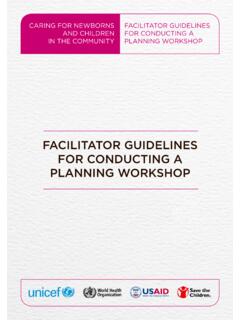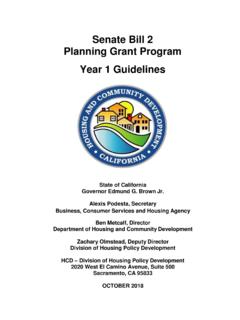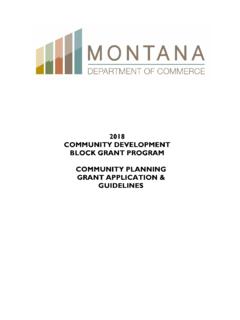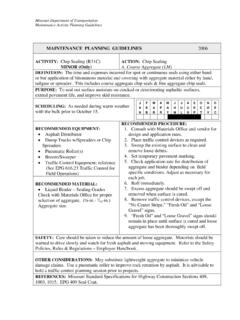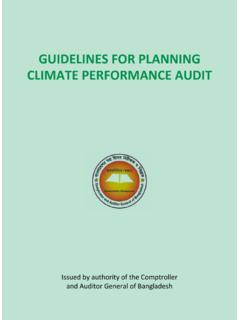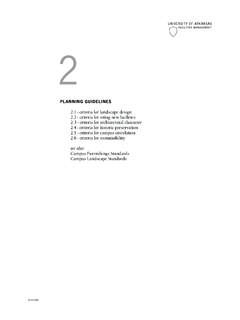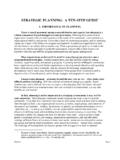Transcription of Transportation System Plan Guidelines Planning Context
1 Page | 1 Transportation System Plan Guidelines Planning Context White Paper 5/30/17 Transportation System Plan Guidelines Planning Context Introduction In 1995, the State of Oregon created and published the first edition of the Transportation System Plan Guidelines (TSP Guidelines ). These Guidelines were subsequently updated in 2001 and 2008. The TSP Guidelines were created to assist local jurisdictions in the preparation and update of city and county Transportation System Plans (TSPs) and Regional Transportation System Plans (RTSPs). Consistent with the original intent, the Guidelines have helped jurisdictions (cities, counties, and metropolitan Planning organizations) develop plans that meet local needs and comply with state regulation and policy direction, including applicable elements of the Oregon Administrative Rule 660-012-000, otherwise known as the Transportation Planning Rule (TPR), as well as the Oregon Transportation Plan (OTP) and associated mode and topic plans.
2 Since 2008, changes to federal requirements, the state regulatory framework, statewide Planning and policy direction, and an evolution in focus of local Planning efforts have established a need to once again update the TSP Guidelines . The following white paper is one of a series being produced to help inform the overall direction of the TSP Guidelines Update. The intent of this white paper is to: the local, regional and state Planning framework for TSP Planning . strategies for maintaining consistent policies and requirements across agencies and jurisdictional boundaries.
3 2 | Page Transportation System Plan Guidelines Transportation Systems Plans Overview TSP Planning outcomes and objectives must be adequate to meet local, regional and state needs (OAR 660-012-0030) by supporting established policy, long-range Planning , development requirements, and other broader objectives. Transportation Planning must take place in coordination with land use Planning to ensure coordination among affected local governments and Transportation service providers and consistency between state, regional and local Transportation plans (OAR 660-012-0000(1)(h)) and to ensure Transportation systems are adequate to serve planned land uses.
4 Other policy efforts that may relate to or impact Transportation Planning include, but are not limited to economic development, urbanization, and parks and open space Planning . How this coordination is achieved, and what is accomplished through it, will be explored in the Planning Integration section of this paper, including specific application, coordination, and consistency issues that are common to Transportation System Planning in Oregon. Local adoption of a TSP is supported by findings of compliance with not only the applicable statewide Planning goals, but also the jurisdiction s acknowledged comprehensive plan policies and land use regulations.
5 Comprehensive plan policies and land use regulations may be reconsidered or modified as part of the TSP adoption and implementation process or subsequent to it. Most communities throughout the state have an adopted TSP; the majority of System Planning efforts will focus on updating existing plans to reflect changing community needs. The scope of TSP updates varies depending on community Context . Updates may be focused on addressing specific issues safety, modal considerations ( bicycle and pedestrian Planning ) or on developing an up-to-date constrained project list. The jurisdictional responsibilities at each level of government directly relate to the types of Transportation facilities, services and programs that must be planned for in a TSP.
6 There are also noteworthy areas where jurisdictional responsibilities overlap, including: County roads in incorporated areas Areas where urban levels of development are predicted, Where transit service extends across jurisdictions on facilities not owned by the transit provider. 3 | Page Transportation System Plan Guidelines Planning Framework Federal Framework Federal Transportation legislation, Fixing America s Surface Transportation Act (FAST Act), was enacted December 4, 2015. The FAST Act replaced Moving Ahead for Progress in the 21st Century Act (MAP-21), and continues the performance-based program implementation enacted in MAP-21, including making available Transportation Performance Management Pursuant to the federal requirements, proposed projects must implement monitoring measures and performance evaluation measures responsive to MAP-21 and FAST Act requirements and relevant to the type of project and project With the passage of FAST Act, the Federal Surface Transportation Program (STP) was replaced by the Surface Transportation Block Grant (STBG) program.
7 The program provides flexible funding that may be used by states and local agencies for projects to preserve and improve the conditions and performance on any federal-aid highway, bridge, or tunnel; projects on any public road; pedestrian and bicycle infrastructure projects; and transit capital projects, including intercity bus State of Oregon Framework Enabling Legislation In 1973, Governor Tom McCall signed Senate Bill 100 into law, creating the framework for land use Planning in Oregon. It established the Land Conservation and Development Commission (LCDC) and established Statewide Planning Goals, including Goal 12 Transportation , which defines the State s policies on Transportation .
8 Senate Bill 100 also requires local jurisdictions to develop comprehensive plans. Local comprehensive plans must be consistent with all of the Statewide Planning Goals,4 including the TPR; consequently the objectives and outcomes of a TSP must be consistent with and supportive of the local comprehensive plan. State Transportation Planning Rule Oregon Administrative Rule (OAR) 660 Division 12 is the State s Transportation Planning Rule (TPR), intended to implement Goal 12. It requires that the Oregon Department of Transportation (ODOT) prepare, adopt, and amend a state Transportation System plan, the Oregon Transportation Plan (OTP).
9 1 2 3 and 4 | Page Transportation System Plan Guidelines It also requires most5 jurisdictions to prepare and adopt a regional or local Transportation plan that serves as the Transportation element of a comprehensive plan (OAR 660-012-0015).6 One of the stated purposes of the TPR is to set out the requirements for coordination among affected levels of government and Transportation service providers for preparation, adoption, refinement, implementation and amendment of Transportation System plans (660-012-0000(4)). Pursuant to the TPR, TSP adoption constitutes a land use decision regarding the need for Transportation facilities, services and major improvements and their function, mode, and general location; as such, findings of compliance with applicable statewide Planning goals and acknowledged comprehensive plan policies and land use regulations must be developed in conjunction with the adoption of the TSP.
10 The OTP is the overarching policy element of the State Transportation plan addressing statewide Transportation needs and investments. The OTP does not identify specific projects for development, but rather provides a policy framework that guides development of statewide mode and topic plans, and regional and local Transportation System plans. Metropolitan Planning Organization (MPO), county, and city Planning must be consistent with the OTP and associated mode and topic plans; similarly, they must adopt policy and reflect decisions and projects that support and are consistent with each other. Statewide Planning processes reflect a cooperative approach insofar as statewide Planning and policy also incorporates and respects the policy decisions made by local and regional partners.










